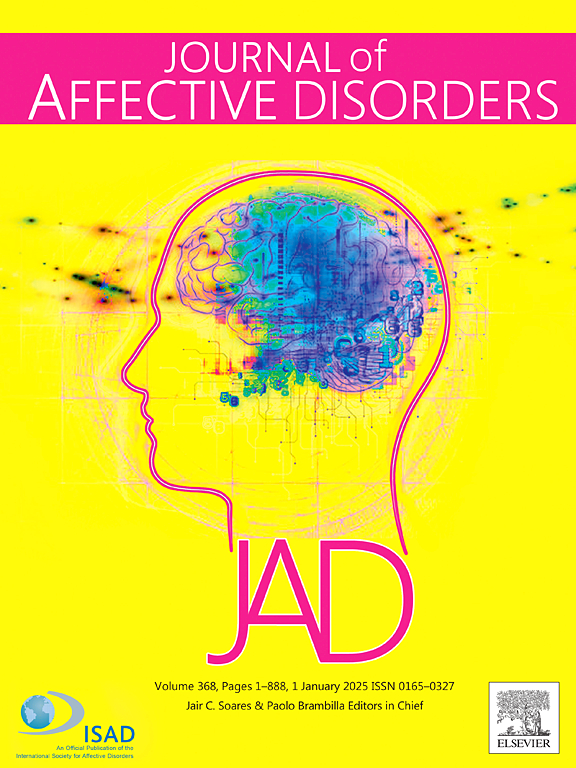Peripheral blood miR-16-5p as a potential biomarker for distinguishing unmedicated bipolar disorder type II from major depressive disorder
IF 4.9
2区 医学
Q1 CLINICAL NEUROLOGY
引用次数: 0
Abstract
Objective
major depressive disorder (MDD) and bipolar disorder type II (BD-II) are difficult to distinguish clinically due to similar depressive symptoms and unrecognizable hypomania symptoms in the early stages. The study aims to identify these two disorders in the early stages through differential expression of microRNAs.
Methods
93 subjects including 66 unmedicated patients (33 MDD, 33 BD-II), and 27 healthy controls (HC) were enrolled. At the time of enrollment, all subjects' demographic data, HAMD, HCL-32, and YMRS scales were assessed. 5 ml of peripheral blood for all subjects was collected for microRNA second-generation sequencing. MicroRNA differential expression, target gene GO and KEGG analyses were performed.
Results
No statistical differences in demographic data were found except for age (BD-II < MDD, P = 0.002). In terms of clinical data, there are differences in the course of the disease (BD-II > MDD, P = 0.037) and the HCL-32 (BD-II > MDD, P < 0.01). A variance analysis of microRNA expressions across all three groups identified eight highly expressed differential miRNAs (P < 0.001), Pairwise comparisons revealed that the expression level of miR-16-5p was lower in both MDD group (P < 0.05) and BD-II group (P < 0.001) than in HC group, and it was even lower in BD-II group compared to MDD group (P < 0.01). The area under the curve (AUC) for miR-16-5p in differentiating BD-II from MDD groups was 0.723 (P = 0.003).
Conclusions
Peripheral blood miR-16-5p may serve as a potential biomarker for distinguishing unmedicated BD-II from MDD patients.
外周血miR-16-5p作为区分未用药的II型双相情感障碍和重度抑郁症的潜在生物标志物
目的重度抑郁障碍(MDD)与双相情感障碍II型(BD-II)由于早期抑郁症状相似,且轻躁症状难以识别,临床上难以区分。本研究旨在通过microrna的差异表达在早期阶段识别这两种疾病。方法93例患者,其中未服药患者66例(重度抑郁症33例,BD-II型33例),健康对照27例(HC)。入组时,对所有受试者的人口统计数据、HAMD、HCL-32和YMRS量表进行评估。采集所有受试者外周血5ml进行microRNA二代测序。进行MicroRNA差异表达、靶基因GO和KEGG分析。结果两组人口统计数据除年龄外无统计学差异(BD-II和lt;Mdd, p = 0.002)。在临床资料方面,在病程上存在差异(BD-II >;MDD, P = 0.037)和HCL-32 (BD-II >;MDD, P &;0.01)。对所有三组的microRNA表达进行方差分析,确定了8个高表达的差异mirna (P <;0.001),两两比较显示miR-16-5p在MDD组的表达水平较低(P <;0.05)和BD-II组(P <;0.001),而BD-II组比MDD组更低(P <;0.01)。miR-16-5p在BD-II与MDD组鉴别中的曲线下面积(AUC)为0.723 (P = 0.003)。结论外周血miR-16-5p可能是区分未用药的BD-II和MDD患者的潜在生物标志物。
本文章由计算机程序翻译,如有差异,请以英文原文为准。
求助全文
约1分钟内获得全文
求助全文
来源期刊

Journal of affective disorders
医学-精神病学
CiteScore
10.90
自引率
6.10%
发文量
1319
审稿时长
9.3 weeks
期刊介绍:
The Journal of Affective Disorders publishes papers concerned with affective disorders in the widest sense: depression, mania, mood spectrum, emotions and personality, anxiety and stress. It is interdisciplinary and aims to bring together different approaches for a diverse readership. Top quality papers will be accepted dealing with any aspect of affective disorders, including neuroimaging, cognitive neurosciences, genetics, molecular biology, experimental and clinical neurosciences, pharmacology, neuroimmunoendocrinology, intervention and treatment trials.
 求助内容:
求助内容: 应助结果提醒方式:
应助结果提醒方式:


